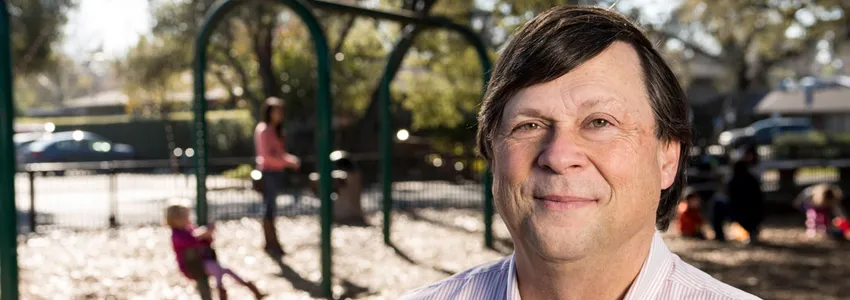
Photo by Steve Fisch: Mark Davis and his colleagues have found that vast numbers of certain immune cells remain in circulation well into adulthood, contradicting beliefs that the cells were weeded out in childhood.
Stanford Medicine News Center - May 19th, 2015 - by Bruce Goldman
Decades’ worth of textbook precepts about how our immune systems manage to avoid attacking our own tissues may be wrong.
Contradicting a long-held belief that self-reactive immune cells are weeded out early in life in an organ called the thymus, a new study by Stanford University School of Medicine scientists has revealed that vast numbers of these cells remain in circulation well into adulthood.
“This overturns 25 years of what we’ve been teaching,” said Mark Davis, PhD, professor of microbiology and immunology and director of Stanford’s Institute for Immunity, Transplantation and Infection. Davis, the senior author of the new study, is the Burt and Marion Avery Family Professor and a Howard Hughes Medical Institute investigator. The lead author of the study, published May 19 in Immunity, is Wong Yu, MD, PhD, a clinical instructor in hematology and a research associate in the Department of Microbiology and Immunology.
The vertebrate immune system is a complex of many specialized cell types working together to recognize and wipe out foreign invaders and developing tumors. T cells — so-named because they mature in the thymus — come in two major varieties. One particular class of these cells, called cytotoxic T cells or “killer T cells,” is particularly adept at attacking cells harboring viruses or showing signs of being or becoming cancerous.
As T cells proliferate in early development, they undergo frequent DNA “scrambling” in a critical part of their genome. This DNA rearrangement results in an astounding diversity in which kinds of pathogens or unfamiliar tissues individual T cells can identify and distinguish from healthy, familiar tissues. Numerous rounds of cell replication bequeath the immune system a formidable repertoire of such cells, collectively capable of recognizing and distinguishing between a vast array of different antigens — the biochemical bits that mark pathogens or cancerous cells as well as healthy cells. For this reason, pathogenic invaders and cancerous cells seldom get away with their nefarious plans.
The current theory
But this same random-mutation process yields not only immune cells that can become appropriately aroused by any of the billions of different antigens characteristic of pathogens or tumors, but also immune cells whose activation could be triggered by myriad antigens in the body’s healthy tissues. This does happen on occasion, giving rise to autoimmune disease. But it happens among few enough people and, mostly, late enough in life that it seems obvious that something is keeping it from happening to the rest of us from day one.
Much of the reasoning regarding why we aren’t all under constant autoimmune attack derives from mouse studies, carried out with techniques that by today’s standards are relatively primitive.
“A whole lot of that mouse work indicated that self-specific T cells are efficiently wiped out in the thymus — that as T cells mature in the thymus, some process within that organ singles out self-targeting T cells and marks them for destruction, and very few of them ever make it out of there alive,” said Davis. “The problem with this, though, was that it would create ‘holes’ in our immune repertoire that pathogens could exploit by evolving ways to exploit these blind spots. But we’ve shown here that in both people and mice, self-specific T cells are not efficiently removed. While many are, lots of these cells get through, and so we don’t believe there are any ‘holes’ to worry about.”
For the study, Davis and his colleagues exposed T cells obtained from human blood donors to a number of “self” antigens, as well as several viral antigens. They were able to identify and count T cells targeting each of these antigens by using a sophisticated approach Davis pioneered in the 1990s. The approach allows researchers to distinguish small numbers of human T cells that recognize a particular antigen from the tens of millions of surrounding ones that don’t.
Looking at blood from dozens of human adult donors, the scientists found that the frequency of killer T cells recognizing self-antigens was almost equal to that of those recognizing foreign antigens. This in itself was a surprising result, challenging the assumption that wholesale destruction of self-reactive killer T cells had taken place in these donors before they’d reached adulthood. (The thymus begins to shrink in early adolescence, eventually withering and largely turning to useless fat.)
Why lots of killer T cells don’t attack us
Davis and his associates then took an interesting tack. They compared men’s and women’s relative frequencies of T cells that recognized a protein encoded by the Y chromosome and that therefore only manifests manifested in males. To women, this antigen is “foreign;” to men, it’s “self.” The researchers found that killer T cells targeting this antigen were only one-third as prevalent in men’s blood as in women’s. This implied, however, that only about two-thirds of killer T cells targeting this antigen in men had disappeared, leaving a substantial fraction of T cells that in principle should be able to attack any cell manifesting the target antigen — and there are all kinds of such cells in a man’s body. Yet the male donors in the study showed no signs of autoimmunity.
In a further experiment, Davis’ group tested the breadth of donors’ immune repertoires against an antigen from a strain of the hepatitis C virus. This antigen is a small piece of one of the virus’s proteins. Proteins are long strings of 20 different chemical building blocks called amino acids. The scientists created 20 versions of the antigen by substituting, at the same position along this snippet, one after another of the 20 amino acids. Doing this changed the antigen’s shape and biochemical properties. No matter which amino acid the scientists inserted at this particular position on the snippet, there were always some T cells within the donor’s repertoire that recognized it. Thus there were no “holes” that pathogens could have evolved to exploit.
But it’s a Faustian bargain, Davis said. Or, put more benignly, a calculated risk. What keeps all those self-targeting killer T cells that aren’t destroyed from running amok and attacking us?
An emergency brake
Another experiment conducted by Davis’ team hints at a possible answer. Using single-cell microfluidics technology invented by Stephen Quake, PhD, a bioengineering professor and co-author of the study, they found that the activity levels of a small number of genes in self-targeting killer T cells differ from those of their foreign-targeting counterparts.
Davis said he thinks those genes may encode proteins that act as an internal emergency brake on self-reactive T cells, making it safe for the immune system to keep them around in case a nasty pathogen comes along against which these cells might put up a heroic defense. In a dish, the self-targeting killer T cells proved more resistant than foreign-targeting ones to immune-signaling substances known to initiate T cell replication and activation.
The downside of the Faustian bargain, Davis said, may occur when strong inflammation, induced by yet other receptors on immune cells that sense viral DNA or bacterial cell walls, becomes sufficiently intense to release a self-targeting T cell’s emergency brake. While that might help to stave off a pathogen featuring an antigen that is very similar to the self-antigen this T-cell recognizes, it could also possibly trigger autoimmunity.
Other Stanford authors are postdoctoral scholars Niang Jiang, PhD, and Brian Kidd PhD (now both at Icahn School of Medicine at Mount Sinai, New York), Keishi Adachi, DVM, PhD (now at Nagasaki University, in Japan), Evan Newell, PhD (now at Singapore Immunology Network, in Singapore) and Michael Birnbaum, PhD; former graduate student Peter Ebert, PhD (now at Genentech); graduate student Peder Lund; former MSTP student Jeremy Juang, MD, PhD; research assistant Tiffany Tse (now at Fluidigm, Inc.); and Darrell Wilson, MD, professor and chief of pediatric endocrinology and diabetes at Lucile Packard Children’s Hospital Stanford.
The study was funded by the National Institutes of Health (grants U19AI090019, U19AI057229, 1K08DK093709 and R00AG040149), the Howard Hughes Medical Institute and the Damon Runyon Cancer Research Foundation.
Stanford’s Department of Microbiology and Immunology also supported the work.



